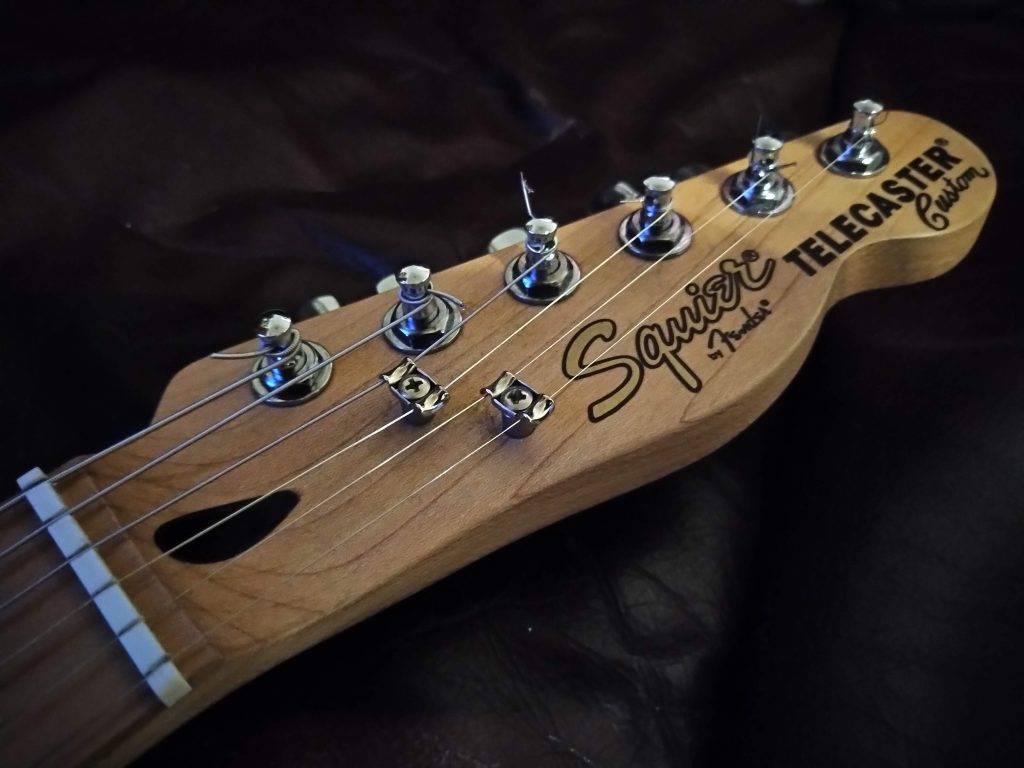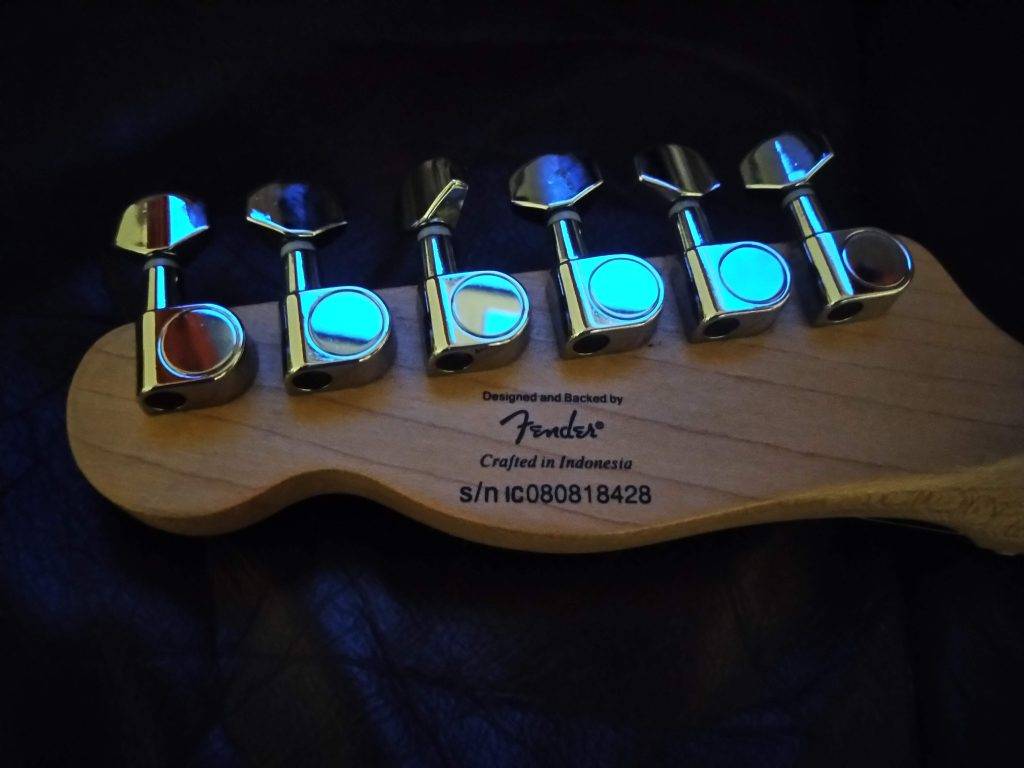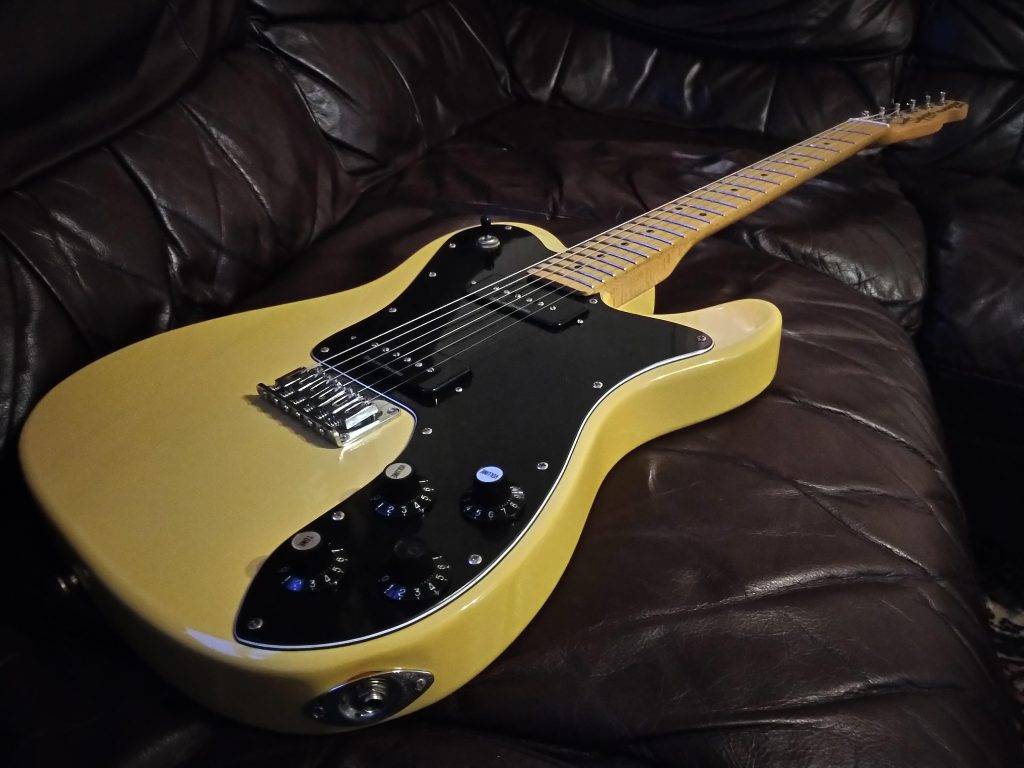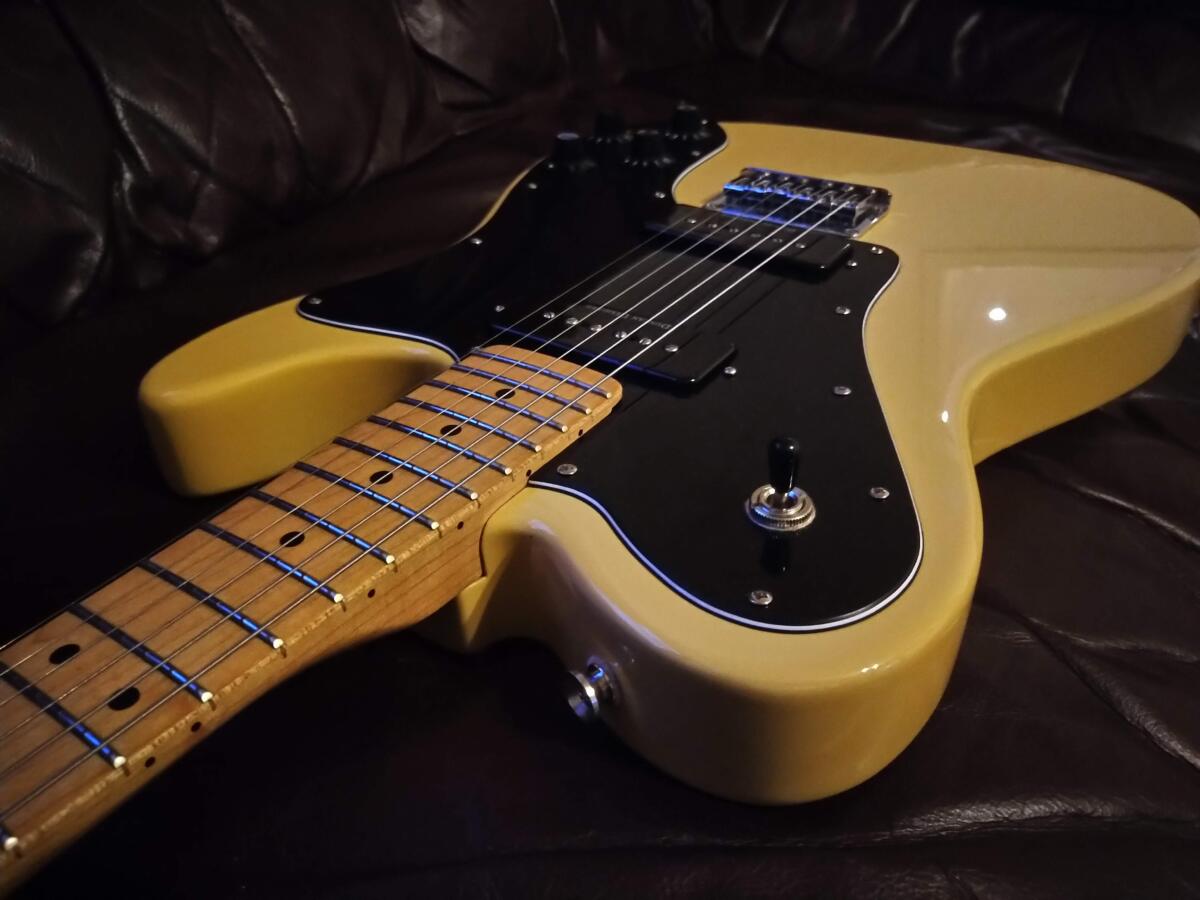I could write a list as long as my arm on the guitars I’ve owned, so why have I chosen the Squier Telecaster Custom with P90’s as my gigging workhorse?
The ‘Invisible’ Neck
The Squier Telecaster Custom’s one-piece maple neck is superb at any price point, let alone the sub-£200 one. It’s your typical Fender 25.5 inch scale length with a modern C profile, providing no hindrances whatsoever, with the added bonus of the 22nd fret for those bends up to the 2nd octave. The frets present no issues either, not so big that they impede long slides up and down the neck and not so skinny to hamper bending. We also have my preferred Fender features of straight string pull and a fingerboard nut cut pretty much perfectly with a 42mm string spacing which, again, presents no nasty surprises and accommodates any style.
In stark contrast to these modern appointments, we have the more vintage-inspired 7.25″ radius maple fingerboard. Some may prefer a flatter, modern profile, but for me this is perfect, melding into the arch of my hand like a glove, providing maximum confidence and speed in whatever I play.
It really is a beautiful neck. Solid and reassuring, but also with that elusive but unmistakable quality of being effortless to play, to the point where you take more risks, get more creative, and push your playing that little bit harder, because you know the guitar won’t let you down. This neck almost disappears in your hand.

The Astounding P90 Bridge Pickup
On paper, the Duncan Designed P90-2 Alnico 5 pickups aren’t the best that money can buy, but, whether by a happy accident or not, the bridge position on this guitar simply delivers. For most of my gigging life, I’ve lived on the Gibson 498T in the bridge position of my Les Paul, which provided just the right balance of power and cut to be able to sustain into harmonic feedback but also be heard above a band mix.
The p90 in this Squire Telecaster Custom gives me that and more. There’s more poke and clarity than a Gibson Les Paul, thanks to the p90 configuration, maple neck and body construction, but more girth than a standard Fender Telecaster with single coils thanks to the fatter P90 configuration.
For cleaner and arguably more authentic country/bluesy styles, maybe you’ll need the more traditional Tele setup. But for my use-case: a solid medium to high gain platform for live indie/rock/pop use, it’s a perfect balance.
Some will argue that Fenders don’t have the sheer weight of tone that a Gibson possesses. These days, I’m of the opinion that, for live use at least, a lot of the additional low – low-mid frequencies you get from a Gibson are cancelled out in a band context anyway. That’s precisely why I can get my tone on the Squier Telecaster Custom just as easily as I ever did on my old Gibson Les Paul.

Legendary Fender Telecaster Durability
The Fender Telecaster is arguably the most durable electric guitar ever made, and a lot of that original design has made it onto the Squire Telecaster Custom. To start, we have, of course, the classic bolt-on neck with no neck angle, a set of solid tuners accompanied by a couple of similarly solid sting trees which are going nowhere.
Where the Squier Telecaster Custom differs is the 3-way toggle switch on the upper bout and the tone and volume for each pickup, Gibson style. I’ve owned Teles before and this layout is a lot better for me as the traditional Tele pickup selector is in a prime location to get knocked if you aren’t careful and haven’t adjusted. There’s nothing to inadvertently knock on this guitar.
Worry-free Simplicity
2 pickups with volume and tone each. 3-way toggle. No trem. One piece bridge. It can get simpler, but this is the minimum I can get away with in a gigging guitar, as I need to be able to switch between distinct rhythm and lead tones at various times without pedals. The lack of tremolo arm, along with the guitar’s inherent durability gives me the confidence to do away with a guitar case and sling it over my shoulder in a gig bag.

The Squier Telecaster Custom’s unique blend of Features
The Squier Telecaster Custom blends modern and vintage features into a package perfectly suited to my playing style and tone needs.
- The neck melts into your hand.
- I can set up perfect intonation and action with the 6 saddles individually adjustable saddles, as opposed to the compromise of 3,
- It won’t slice my hand open on the traditional Tele slider switch,
- I can switch between different volume/tone setups for the pickups.
- I can carry it in a gig bag without fear of the neck snapping or damage to the trem system.
- It sounds fatter than a normal Tele, but cuts through better than a Les Paul, thanks to the high output P90’s.

Astonishing Value
Put everything together, and similarly to the amazing BOSS Katana 50 (full review here), we have a great-sounding, dependable, gig-able instrument for under £200. If you really can’t live without the big ‘F’ on the headstock, you’ll need to pay exponentially more. (Although it actually does feature a smaller ‘F’ under the Squier logo).
Alas, the Squier Telecaster Custom isn’t without issues….

The worry of the Telecaster Jack Socket
The Achilles heel of any Fender (or Squier) Telecaster has always been the archaic jack socket design. What you have is a bent steel ‘retainer clip’ with teeth biting into the walls of the jack socket hole, held in place only by the tensioning of the jack socket nut itself.
Of course, given regular use, the socket works loose until, eventually, either the input jack itself twists its way free of its solder joints, or, in my case the retainer clip fails and drops out, rendering it useless. It’s a simple fix, you simply replace the socket with either an ‘electro-socket’ which is a standard Telecaster socket but with screw holes on the inside, or, if keeping the original appearance isn’t a concern, a standard Gibson style socket-plate with the screws on the front-face will solve the problem permanently.
I have no idea why Fender continues to use the original (terrible) design.

Disappointing Neck Pickup
I’ve always loved neck pickups, especially the 490R on my Gibson Les Paul, that thick, soupy ‘Woman Tone’, the intro to ‘Sweet Child ‘o Mine’. It has so many uses. I’m also a huge fan of a neck p90, especially on a mahogany-bodied guitar. It’s plummy, flutey, musical, and the ideal foil to the brashness of the treble selection.
But this P90 on this agathis-bodied Squier Telecaster Custom? Well, I can’t get it to work at all. On paper at least, it’s the exact same unit as the bridge, but all I can hear is that it’s much cleaner, much lower output, giving you an unpleasant tinniness to whatever you play, no matter how much gain you apply to thicken it up. For me, the neck should always sound bigger, warmer, maybe at the expense of some high-end. Here, all your really getting is high end, but without the poke of the bridge, no matter how you set it up. Is this down to the body material? Some say agathis is mahogany on a budget. If anyone knows, drop me a comment below.
On the plus side, this clearly defined ‘fault’ can easily be rectified with a decent pickup replacement. I’ve held off for the moment, I wanted to get a feel for the guitar first and a new pickup represents almost 50% of the instrument’s overall value. But now I know I’m staying with the guitar, the upgrade will pay for itself with gig money.
For clean playing, the unit is much less offensive, giving you the all the depth that’s missing with overdrive, and the zingyness now useful rather than annoying.
Banana-sick Colour Scheme
I really wanted the all-black model. All-black Telecasters with maple fingerboards are a thing of beauty. Alas, the advertised butterscotch does clash a little with the black pick-guard. The finish is never going to age gracefully like nitrocellulose, so I’m pretty much stuck with it. It’s an ugly duckling.

The Story Behind the Guitar.
It’s not all about sounds and hardware. This Squier Telecaster Custom also holds great sentimental value for me. You may remember an article I wrote a while back Guitar Acquisition Syndrome, well, I ended up with the guitar! It’s true it disappeared from display the day after I saw it in the guitar shop, but the buyer was non-other than my wife, as a surprise present for my birthday! (The best kind).
I’ve been gigging with it ever since.
In Conclusion
If you hadn’t already guessed. I’m in love with this Squier Telecaster Custom. It’s sound, the way it plays, its durability, it’s simplicity/blend of features trade-off. Sure it has its flaws, but these pale into insignificance compared to the amount of guitar you get for your money. It’s got a story and character all of its own and continues to write new pages almost every week.
If you can find a Squier Telecaster Custom with p90s, get one. I’m sure you’ll have a faithful friend for life too.
Specification
- Body: Agathis
- Neck: Maple, C-Shape, (Gloss Polyurethane Finish)
- Fingerboard: Maple, 7.25″ Radius (184 mm)
- No. of Frets: 22 Medium Jumbo Frets
- Pickups: 2 Duncan Designed™ P90-2 Pickups with Alnico 5 Magnets (Neck/Bridge)
- Controls:
- Volume 1. (Neck Pickup),
- Tone 1. (Neck Pickup),
- Volume 2. (Bridge Pickup),
- Tone 2. (Bridge Pickup)
- Pickup Switching 3-Position Toggle:
- Position 1. Bridge Pickup
- Position 2. Bridge and Neck Pickups
- Position 3. Neck Pickup
- Bridge: 6-Saddle Strings-Thru-Body Tele Bridge
- Machine Heads: Standard Die-Cast Tuners
- Hardware: Chrome
- Pickguard: 3-Ply Black
- Scale Length: 25.5″ (648 mm)
- Width at Nut: 1.650″ (42 mm)
How can I get hold of a Squier Telecaster Custom (with P90s) ?
Sadly, this model is now discontinued. If you aren’t willing to pay big bucks for something a lot further up the Fender foodchain, all that’s left outside of the used market is something along the lines of the Squier Classic Vibe (Below) or Vintage Modified series. It’s also worth saying there was also a humbucker equipped version of the Squier Telecaster Custom.

Leave a Reply